Once Upon a Kilobyte: A Brief History of the National Oceanographic Data Center
The National Oceanographic Data Center (NODC) maintains, updates, and provides access to marine environmental and ecosystem data and information. Collected data include physical, biological, and chemical measurements derived from in situ oceanographic observations and satellite remote sensing of the oceans. This information is used to monitor global environmental changes.
From rudimentary water sampling equipment and techniques to modern-day satellite surveillance, from kilobytes of data to terabytes per day, we have studied our seas. Despite advances to date, we are only just beginning to understand this "last frontier."
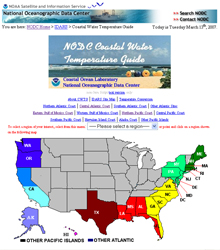
The NODC Coastal Water Temperature Guide presents water temperatures and climatological averages for U.S. coastal areas based on observations from NOAA tide stations and National Data Buoy Center buoys. Click image for larger view.
Since 1960, the National Oceanographic Data Center (NODC) has been charged with archiving global physical, chemical, and biological oceanographic data. These long-term historical observations have played heavily in environmental impact studies, global climate change studies, and validation of ocean data collected via satellites. Once primarily of national economic and security importance, such data are of increasing interest to the general public. For example, the NODC "Beach Temperature" site is the Center's most popular Web offering and increased hurricane activity over the last few years has increased the interest of "armchair" scientists in surface ocean temperatures.
This article traces the origins of the NODC, telling the story of how we came to be, some of the initial obstacles encountered, and how we got our feet wet without drowning in the data.
A Growing Need for Oceanographic Data
There has always been a curiosity, and certainly a need, to know about our water planet. Between 1872 and 1876, the H.M.S. Challenger undertook the first major attempt to gather systematic global ocean data. Coastal and Gulf Stream data were already being routinely collected by various government agencies by then, and it was becoming obvious that understanding our marine environment, both locally and globally, was in our national best interest. During World War II, the threat of enemy submarines made the need for subsurface water temperatures and salinities critically obvious, as better knowledge of these factors meant better detection capabilities.
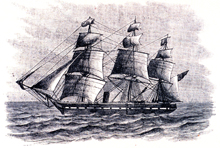
The H.M.S. Challenger preparing to sound, 1872. Click image for larger view.
The U.S. Bureau of Commercial Fisheries was also increasingly interested in catch statistics and in how the physical parameters of our coastal waters affected economically important species. The loss of the Titantic taught us that we needed to have better data on icebergs.
By the mid-1950s, calls were being sounded for a central repository for these various collections of data, thus leading to the efforts that would eventually result in the birth of the National Oceanographic Data Center.
Public Interest
Although there was a definite need for oceanographic data for national economic and security reasons, use of such data has increasingly become important to the average citizen. By the early 1900s, Americans began having more free time and more disposable income. Questions such as "I am going to be taking part in a long-distance swim next weekend...will I need a wetsuit?" became increasingly commonplace.
Vacations at the beach and ocean swimming were suddenly very much "in vogue." In 1916, a series of shark attacks along the New Jersey coast sent cries to "do something!" reverberating all the way to Congress and the White House. Unfortunately, knowledge of sharks, especially in U.S. waters, was sorely lacking. Even if such data had existed, there was no central place to look for the information.
Today, the rush to coastal beaches for summer holiday or to the islands for a winter break have many people looking up the water temperatures they are likely to encounter. Recreational sailors, divers, and fishermen want to know about currents and water temperatures to more effectively enjoy their sport. Having these data available in a single location benefits our country and our society in ways we may never have imagined 200, 100, or even 50 years ago.
A Movement to Create a Central Repository
Until the advent of satellites, the gathering of most marine data depended upon scientists going out into the field and collecting measurements. All of the great scientific expeditions of the early 20th century, while providing much more data than ever before, still provided only a snapshot of a planet whose surface is covered by more than 70 percent water.
This snapshot was also very fragmented because there was no central repository for collected data. There was no one place for researchers to go to see what data had already been collected and where data were incomplete. No single location existed for researchers to share and compare data.
Getting Started
In 1954, Dr. Oscar Elton Sette, of the Bureau of Commercial Fisheries, attended the second annual Eastern Pacific Oceanic Conference (EPOC). It was at this conference that Dr. Sette first put forth the call to establish a central location for storage and dissemination of oceanographic data. It was another five years before that suggestion was acted upon.
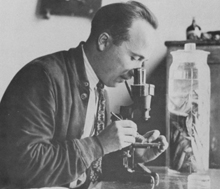
O. E. Sette, Director of the Bureau of Commercial Fisheries Laboratory in 1929, examining larval mackerel. Click image for larger view.
In April of 1959, the National Academy of Sciences Coordinating Committee established a Working Group on Oceanography. This group recommended that "a National Oceanographic Data Center be established at the U.S. Navy Oceanographic Office in Suitland, Maryland. That this center be financed, administered, and policies of operations determined jointly by the Navy, the Coast and Geodetic Survey, and the Bureau of Commercial Fisheries."
Legislative Action
Later that year, Senator Magnuson (D-WA) sponsored a bill proposing the "establishment of a national oceanographic records center to assemble, prepare, and disseminate all scientific and technical oceanographic and closely related data..." The bill also recommended formal international cooperation in the marine sciences and suggested the center be created within the Department of Commerce.
A bill was introduced into the U.S. House of Representatives in May 1960 to "establish within the...Coast and Geodetic Survey a National Oceanographic Data Center...The function of the [NODC] shall be to acquire, assemble, process, and disseminate all scientific and technological and oceanographic and related environmental data, including but not limited to physical, biological, fisheries, hydrographic and coastal survey, meteorological, climatological, and geophysical data."
The NODC Is Born
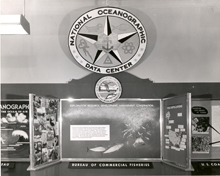
The original NODC logo, displayed over a variety of exhibits during the official NODC dedication ceremony, reflects the various agencies that contributed to this new organization. Click image for larger view.
Neither of these bills were acted upon or passed into law; however, the Interagency Committee on Oceanography submitted similar recommendations to the Federal Council for Science and Technology. On December 23, the NODC was officially established with an interagency charter signed by the Navy, the Departments of Interior and Commerce, the National Science Foundation, and the Atomic Energy Commission. The deed was done!
Data Sharing
Although a national data repository was endorsed by such prestigious organizations as the EPOC and the National Academy of Sciences, there was considerable trepidation among individual scientists. There was a prevailing "every scientist for him or herself" attitude that precluded much data sharing. Lack of standardization was part of the reason; scrambling for funding was another. Scientists tended to trust only their data, and they were not thrilled with the idea of using conglomerated data from a government entity. Convincing scientists to submit and share their data for the common good was a challenge that needed to be overcome.
Lack of standardization on any front became rapidly apparent. Scientists were not consistent with one another in how the data were collected, what units data were recorded in, or what media were used. The fledgling Data Center was now faced with photographs, coding sheets, punch cards, publications, log sheets, strip charts, glass slides, magnetic tapes, etc. Wave and ocean current data arrived in a variety of codes and from a wide spectrum of recording instruments. Ice data submissions arrived as digital data, as descriptive information, and as photographs taken from a variety of angles. The challenge was to digitally store these various data, and somehow be able to retrieve them as needed.
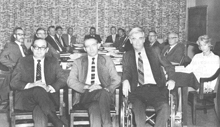
NODC Advisory Board meeting, September 8, 1970. Included in the photo are Dr. Thomas Austin, NODC Director, and Annette Farral, both seated to the right. Click image for larger view.
Fortunately, the NODC Charter also established an Advisory Board to "afford...an effective means of formulating, expressing, and transmitting joint policy and technical direction to the said Data Center." This Board included one member from each of the sponsoring governmental agencies and two non-voting members from the National Academy of Sciences.
With the help of this Advisory Board and members of the oceanographic community at large, standardized data formats were created for a variety of data. Computer processing was developing rapidly. Soon it was much easier to share and compare data collected by various scientists and programs. Over time, it became obvious that commonly shared data was cost-effective and a time saver. And, as marine research became more sophisticated, a hard truth slowly dawned on researchers: their independent disciplines of biology, chemistry, meteorology, etc., were all interrelated. Having access to a variety of data collected by experts in other fields which was quality controlled was actually good!
Now, scientists thought, if only we could get ships to every spot in the ocean, multiple times, and if only computers could store unlimited amounts of data...
Oceanographic Data Management Today

"C'mon in - the water's fine!" As more and more Americans enjoy the recreational opportunities available along our coasts, interest in the holdings of the NODC have grown. Image courtesy of Mary B. Hollinger.
In a few short decades, early dreams of data that covers the globe and is stored in easy-access computer systems is a reality. Digital data storage is no longer an issue. Satellites are providing unprecedented coverage, not just of weather, but of sea surface temperatures, ocean waves, and even the shape of the ocean bottom. The historical in situ data archived by the NODC has proven invaluable in calibrating and verifying satellite data. These long-term data collections are critical to studies of climate change. NODC Beach Temperature tables gather information from NOAA buoys and tide stations, to help people plan their recreational activities. We have come a long way from the Challenger days!
Contributed by Mary Hollinger, NOAA's National Environmental, Satellite, Data, and Information Service
Works Consulted
Abram, R. (1997). National Oceanographic Data Center: 35 Years of Oceanographic Data Management, Science, and Services. Internal Publication.
Cuzon du Rest, R. (1996). History of NODC. NODC unpublished manuscript.
NODC. (1961). Annual Reports of the NODC (beginning with November 1960–June 1961). Washington, DC.
NODC. (1969). Introduction to the National Oceanographic Data Center brochure. Publication G-1. General Series 1969.
